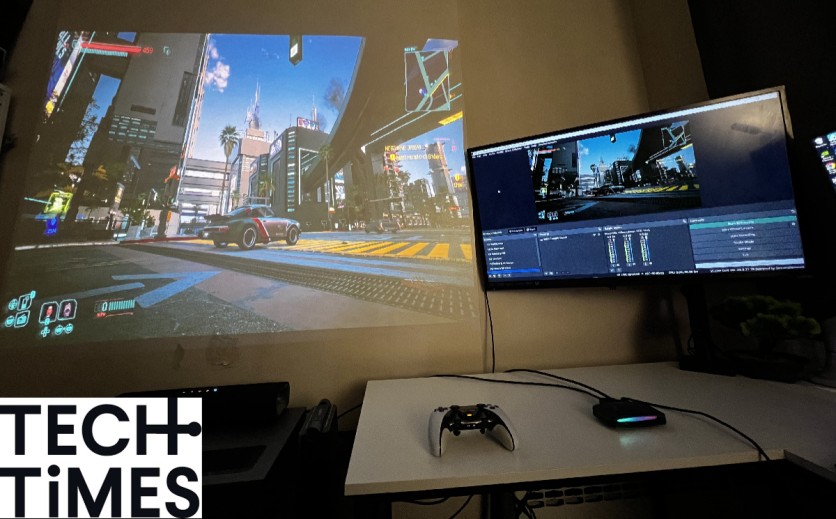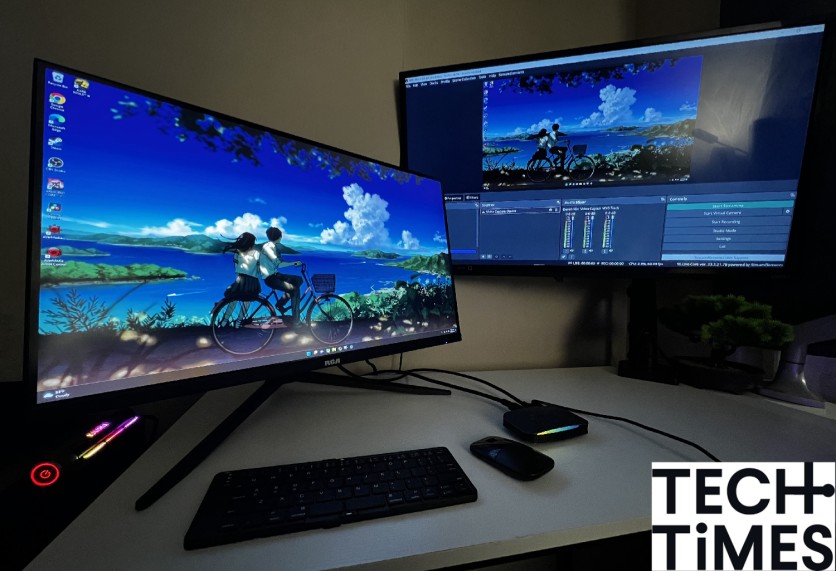Capture cards have seemingly stagnated over the past three years, showing little innovation on how creators can create with games and more. In mid-2022, Elgato launched the HD60 X, an external capture card that was geared toward the modern generation of consoles, ie PlayStation 5 and Xbox Series X/S. Although it is a powerful option for the newest technology, it unfortunately fell by the wayside for some due in large part to the absence of 4K/60fps capture.
Now, however, that's all changed thanks to the revolutionary new introduction of AverMedia's Live Gamer Ultra 2.1 (quite a mouthful). This ingenious capture card leverages (as the name suggests) a 2.1 HDMI input and output passthrough for impeccable results onscreen in tandem with a USB 3.2 Gen 2 type-c interface. It's important to note that not only does the cable necessitate 10Gbps data transfer, but so too does the plug on your PC. Seek out your motherboard's user manual for the proper USB-A insert (it will probably be found on the rear, though).
AverMedia's newest iteration, to the delight of creators around the world, offers a suite of viewing potentials, main among them being its capped max capture rate of 2160p at 60 frames. This is the utter sweet spot for gaming creators, allowing content to shine like never before in both long/short form videos and livestreams. The Live Gamer Ultra hosts support for literally every resolution, too, so it doesn't limit your options either, allowing creators everything from 4K and 1440p to even 480p and 1080i.

When it comes to passthrough, AverMedia pulled out all the stops. Its 4K/60 capture seemingly wasn't enough, so the firm ensured the product allowed for pass-through at up to 2160p at 144fps on HDR or VRR. This is remarkable, allowing PC gamers to stream their content at blazing, smooth intervals, as well as PS5 owners with compatible screens. The company also states that a November 16th firmware update will allow the Live Gamer Ultra ultrawide resolution support of 3440 by 1440 at 100Hz, thus ensuring even the 43:18 crowd and lower isn't left out in the rain.
The product itself looks like any typical capture card, except it also sports this futuristic RGB lighting spectrum that can be adjusted to a user's liking in a variety of ways. Users will have to download two forms of AverMedia software, the Assist Central and Gaming Utility (a bit of an annoying necessity, but it comes with the territory). Unlike Elgato's capture card software suites, AverMedia's doesn't offer a preview window, letting users simply connect to the OBS of their choice for previewing, which in my opinion greatly streamlines the whole process.
The card also comes equipped with two audio input/output jacks for 3.5mm cables inserted on the headset and the controller of your console of choice. This allows for simplistic and easy recording of your on-platform party chats, though with the introduction of Discord on practically every conceivable device, there's really no reason to stress with the 3.5mm jacks if you don't want to. It's a practical touch by AverMedia, showing that it thought of and went the extra mile.
Setup of the device can be a bit tricky if you're not prepared. I'm a bit annoyed that the company doesn't include a USB-C to USB-A cable, as my PC doesn't have a USB-C input. Luckily, I just swapped over the cable from the Elgato HD60S+ I had lying about and it works like a charm, but for those who don't have such luck you will have to purchase a 3.1 Gen 2 cable with 10Gbps data sync separately for proper functionality. I tried using an adapter, but it unfortunately didn't work, so it's best to just get a proper cable.

You'll know if the capture card is plugged into the correct port due to special lighting parameters on the RGB LED window. This will save a lot of time, as the device will literally tell you if you are using compatible ports, flashing orange for USB 2.0 connection, red for "device anomaly," blue for firmware update, and rainbow wave for working properly.
Over the past several days, I've tried messing with this capture card in a whole bunch of different ways. I've tried it with a mini PC, PS5, PS4, Nintendo Switch, and even PS3. It works quite phenomenally on most fronts, offering easy connection, pass-through, and recordings. The bane of it all comes most in the initial OBS setup, depending on the type of content you're recording or streaming.
It has worked quite flawlessly with relatively any input I've thrown its way. PS5 worked wonders via 4K/60 capture of Cyberpunk 2077 and Alan Wake 2. My mini PC also looked wonderful in full HDR support at 1440p and 120fps playing Armored Core 6. There was, however, a tiny bit of noticeable audio lag when watching YouTube videos on the mini PC, but all-in I found its general use case to be literally plug and play without much hassle at all.
It can be a bit finicky with Nintendo Switch. Make sure to redock the console if it's not showing and, if the OBS preview is blank, try unplugging and replugging the capture card in as you should see a "No Signal" page in OBS. You will also have to adjust your OBS output settings for proper 4K video capture, as bitrate and video format all can tank the video if you don't have the right settings.

One thing I will also note is that PS3 support is nonexistent unless you use component video output as per AverMedia's own help page. This is due to the fact that HDCP (High-bandwidth Digital Content Protection) is literally built-in on the console as a security feature, making video capture via HDMI borderline impossible unless you have a special splitter or component wiring. I tried to use a splitter with the Live Gamer Ultra and, interestingly, my PS3 did show up for like five milliseconds before being yeeted into the HDCP oblivion once more, so I'm not sure why that is or how best to amend it. Your only option may be component, which is a bummer but that's more of a PS3 issue.
I also plugged in my GoPro Hero 5 to see if cameras might work with the Live Gamer Ultra and it didn't disappoint. I was surprised to not have to change any specific settings in the software; once again it was as simple as plugging in the camera and it worked flawlessly, a testament to the ingenuity behind the Live Gamer Ultra.

Though I didn't get to test it myself, the Live Gamer does come in a PCIe iteration called the Live Gamer 4K and it essentially sports all of the exact same specs as its smaller external counterpart. Plus, it's at the exact same price of all but a mere $300, an incredible leap in value over similar (yet failed) previous options on the market, like AverMedia's own Live Gamer Bolt or Elgato's 4K60 S+.
This expert pricing puts the Live Gamer Ultra in a hot spot, proving itself as potentially the end all be all of capture devices - at least for right now. Overall, I feel it's hard to knock the Live Gamer Ultra, as it really does pull out all the stops. I mean, AverMedia even ensured to design the device with all necessary inputs on one side for easy, simplified use.

I will have to complain about the shotty software, as well as the fact that there's no USB-A dongle of some kind. I know I'm most definitely in the minority when it comes to having a PC without a USB-C input, but there will be folks out there that might be tacking on an additional $6 to $15 for a separate cable. Fortunately, the product does come with all the essentials, including a 3.5mm cable, 2.1 HDMI, and the USB-C 3.1 Gen 2 offering, so you won't have to run out and get any other special cables - that is unless you don't already have a second 2.1 HDMI.
The Live Gamer Ultra has no sooner become my go-to for recording any capture from my PS5. Previously, I was essentially screen recording on the device, transferring to a USB stick and then moving to my PC, which then required me to encode it for proper colors in HDR. Now, however, that's been completely streamlined thanks to the Live Gamer Ultra, plus its endless amount of support, whether it be in terms of workable devices or resolutions, make this an absolute steal.
On the Tech Times grading scale, I must give the AverMedia Live Gamer Ultra a nine out of ten. I think software support needs a bit of work and limited connectivity in the box for non-contemporary PCs is a slight issue, but the device works wonders practically with any input and is staged at an incredibly competitive price point.
ⓒ 2025 TECHTIMES.com All rights reserved. Do not reproduce without permission.




